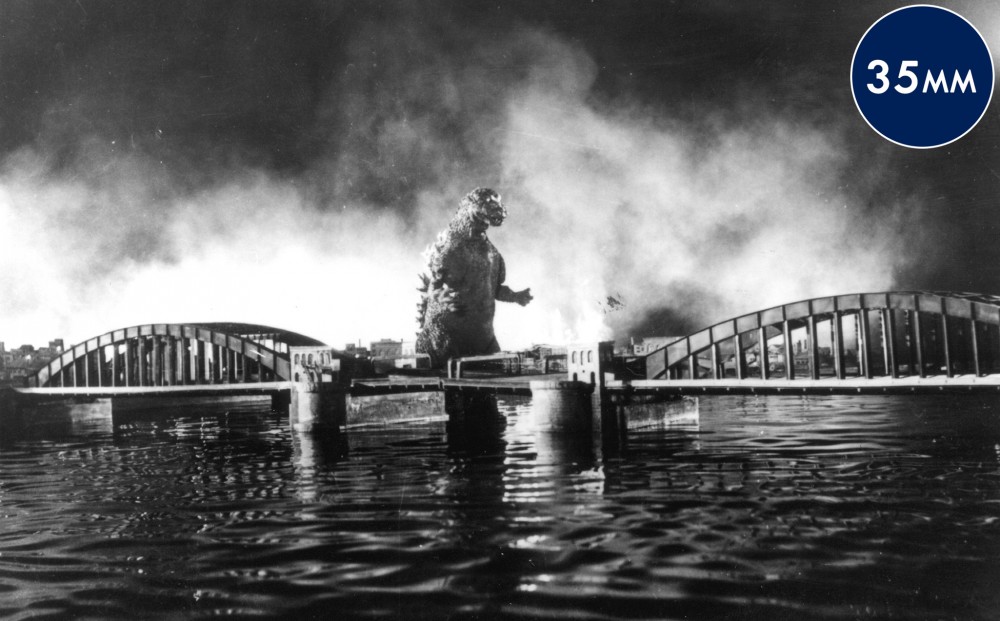GODZILLA
8:45
Saturday, October 26
ゴジラ (Gojira)
Director Ishirô Honda
Cast Akira Takarada, Akihiko Hirata, Takashi Shimura, Momoko Kôchi
Screenplay Takeo Murata, Ishirô Honda, Shigeru Kayama | Cinematography Masao Tamai
1954 | Japan | 35mm | approx. 96 min. | In Japanese with English subtitles
On a sunny day and a calm sea, a Japanese steamer sinks in flames when the sea erupts; a salvage vessel sent to the rescue disappears the same way; exhausted, incoherent survivors babble of a monster – as does an island patriarch; after a typhoon hits the island and villagers disappear, scientists find a giant radioactive footprint! Could it be...? Gojira (the original title, an amalgam of gorilla and kujira – Japanese for whale) was the biggest budgeted film in Japanese history to that time, costing nearly twice as much as the same studio's The Seven Samurai, released in the same year. An enormous hit, it spawned 50 years of sequels, countless rip-offs, and a new genre: the kaiju eiga, or Japanese monster movie. Sold to an American distributor two years later, it was completely re-cut and atrociously dubbed, with added scenes (shot in Hollywood) of a pre-Perry Mason Raymond Burr observing the havoc wreaked by the monster. The re-named Godzilla: King of the Monsters still became mainstream America’s synonym for a classic Japanese movie – and for cheesy movie-making. But that’s the perception of the re-cut American version – in fact, the original Japanese Godzilla is considered one of the great science fiction films by a master of the genre, Ishirô Honda (a close friend of Akira Kurosawa and his occasional second unit director), and a top-notch production team. The U.S. version runs 20 minutes shorter than the original, not including another 20 cut to make room for Burr, so that nearly a third – or 40 minutes – of the Japanese footage was shorn. References to the Bomb were excised: Akira Takarada's salvage expert likening the monster to the H-Bomb; Tokyo commuters wisecracking about how they hope they didn't survive Nagasaki for nothing; and the original cautionary ending. Also lost were the opening credits with the ominous main theme by the great Akira Ikufube, punctuated by the thuds and roars of the off-screen monster; a romantic triangle among Yamane's daughter (Momoko Kôchi), Takarada, and an eccentric eye-patched scientist (Akihiko Hirata); a vituperous session in the Japanese Parliament; a TV announcer’s hilarious blow-by-blow account of Godzilla’s destruction of Tokyo; and more scenes with the real human star of the movie, Takashi Shimura (best known for his Kurosawa roles, including the leader of The Seven Samurai and the doomed man of Ikiru), as a revered paleontologist who insists that Godzilla must be studied, not destroyed (he’s in the minority). This first Godzilla is truly terrifying – not the later dumbed-down near-nice guy versions, all too often seen in artifice-revealing broad daylight. Here he's a 150-foot tall Jurassic reptile, almost always seen at night, intent on stomping any living thing in his path, and, destroying an exquisitely detailed miniature version of Tokyo – a tour de force by Toho's special effects genius Eiji Tsubaraya. Tsubaraya’s use of "suitmation" – the often-belittled “actor in monster suit” method – was due to time and budget restraints, but, in concert with noirish cinematography, Tsubaraya’s low-tech approach is still as thrilling as ever… even in these days of digitized SFX.
Godzilla™ & © TOHO CO., LTD. All Rights Reserved.


